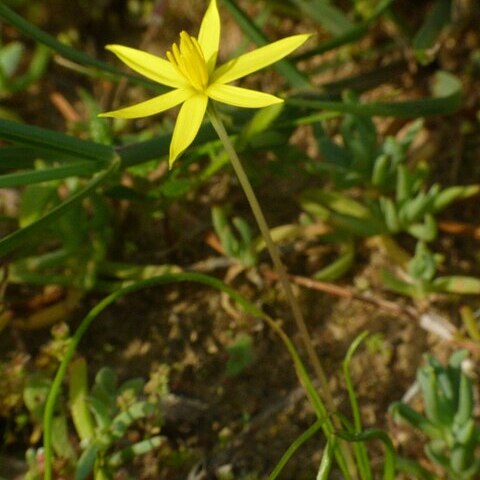Plants 8-38 cm tall. Corm somewhat ovoid, 8-15(-25) mm diam., covered with finely to heavily reticulate, brown, fibrous tunics, cormlets sometimes produced on runners, old corms often persisting laterally as flattened discs; fibres dense, free from basal disc, terminating in a short ring of bristles; roots arising from near corm base. Cataphylls up to ca. 25 mm long, thin-textured. Leaves 2-5(-8), sheathing at base up to ca. 40 mm, suberect to recurved, linear to linear-lanceolate, 50-375 x (1.5-)2.0-6.0(-11.0) mm, tapering evenly upwards, carinate distally, with midrib prominent, leathery, margin entire or irregularly toothed with scattered, recurved teeth. Inflorescences 1 in flower at a time, 1-flowered, usually longer than leaves; scape up to 105 x 1.5-2.0 mm, terete, pale green; bract 1, incompletely sheathing pedicel almost up to tip, linear-lanceolate, involute, 40-110 mm long, keeled, texture leaf-like, midrib sometimes minutely toothed. Flower pedicellate, stellate, yellow or white, rarely cream or pale pink, often centrally spotted, blotched or circled in blackish, bluish, maroon, pale pink or metallic green colours, sometimes with bluish green or yellowish iridescence, backs of outer whorl pale green, striped reddish on midvein and margin, backs of inner whorl often plain, pale green, rarely both whorls without stripes, unscented; pedicel erect, usually remaining so in fruit, 63-230 x 1-2 mm, terete, often hollow distally, greenish to reddish brown; tepals 6, oblong-lanceolate, (10-)14-35(-45) mm long, outer (3.5-)4.0-8.0 (-12.0) mm wide, minutely mucronate, inner 2-7(-9) mm wide. Stamens 6, erect, subequal or outer slightly shorter than inner; filaments inserted on broad style base, tapering upwards from broad base, ca. 1.5 mm long, much shorter than anthers, yellow, yellowish green or blackish; anthers oblong, latrorse, (4-)5-15 x 1.5 mm, basal lobes 0.5 mm long, connective yellow or blackish; pollen pale to deep yellow. Ovary narrowly obconical, 5-20 x 2-5 mm, 3-locular; style ca. 2 mm long, yellow to blackish; stigma branches erect, spreading when old, narrowly oblong-lanceolate to triangular, (2.5-)3.0-8.0 x 1.5-3.0 mm, much shorter than to equalling stamens, pale to deep yellow, densely papillose. Capsule narrowly obconical, 7-20 x 2-5 mm, dehiscence circumscissile. Seeds depressed-ellipsoid, 0.40-0.52 x 0.38-0.42 mm; testa shiny black, colliculate, arranged in ca. 27 longitudinal rows, outer periclinal cell walls hemispherical with a flat basal rim. Flowering period: (June-)August-September(-December).
More
Perennial geophyte, 100-300 mm high; corm capped with short, fine bristles. Leaves ± 5, spreading, linear to lanceolate, 2-10 mm wide, V-shaped in transect, keeled. Flower 1 per scape, star-shaped; tepals 15-35 mm long, yellow (white or pink in SW Cape), often dark-centred, red-striped on reverse; stigma branches long and broad; bract 1, long, leaf-like, wrapped tightly around pedicel. Flowering time July-Oct.
Cormous geophyte, 100-300 mm tall, corm capped with short, fine bristles. Leaves several, spreading, linear to lanceolate, V-shaped in section. Flower 1, variable in size, yellow (occasionally white or pink in CCR), often with a dark centre, red-striped on reverse; bract 1, long, leaf-like, wrapped tightly around pedicel.
Cormous geophyte, 10-30 cm. Leaves 2-8, spreading, V-shaped in t/s, usually toothed. Flower 1, stellate, yellow, white or occasionally pinkish, centre often iridescent, spots occasionally non-iridescent, striped beneath, filaments short, bract 1, leaf-like, sheathing.

